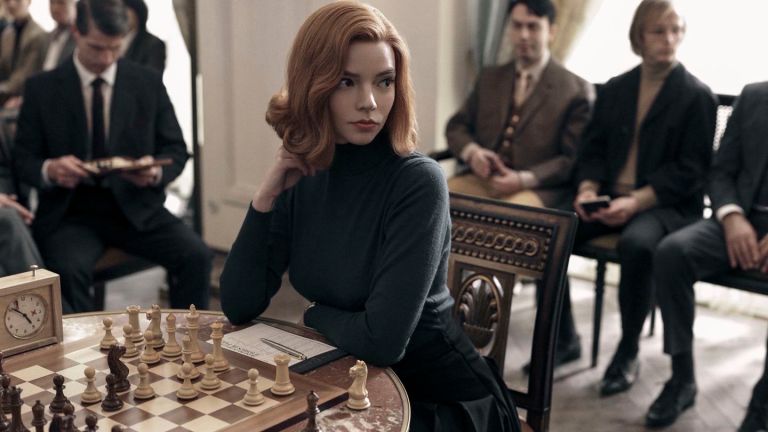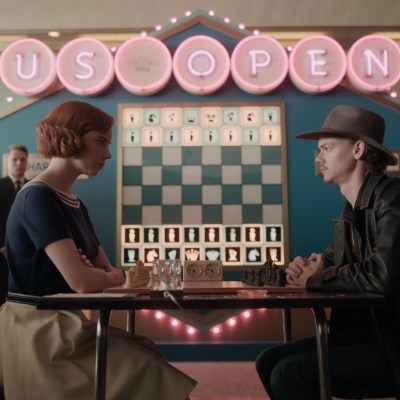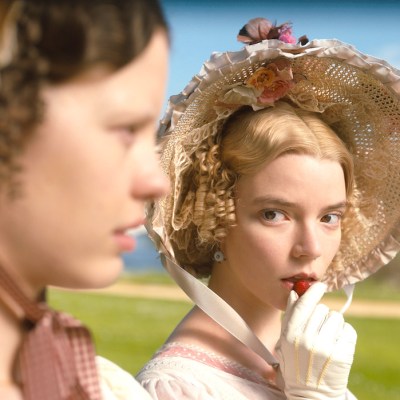The Queen’s Gambit: Why ’60s Retro Feels So Fresh in 2020
Netflix and Anya Taylor-Joy’s The Queen’s Gambit is the rare thing: a streaming series with staying power in the zeitgeist. We examine why.

This article contains mild The Queen’s Gambit spoilers.
It’s not the image that first springs to mind when you think of chess. In a swanky Parisian parlor, with a bank of breathless photographers following her every gesture, Anya Taylor-Joy’s Beth Harmon rushes in while still in a daze. She’s clearly missing a step after a late night of bad decisions, yet even at her most disheveled she emanates ‘60s style.
Like Ann-Margret in The Cincinnati Kid, Beth’s fiery mane of red hair is turned up at the sides in a flip. The idol of her age. But with that 1965 movie, Ann-Margret was peripheral, an underdeveloped distraction to a story about grizzled men playing grisly high-stakes poker. Beth is the Cincinnati Kid here, or at least the Lexington Prodigy: a young woman breaking into the boys’ club and who is about to challenge Russia’s greatest chess player in front of the whole world. And she’s doing it with a hangover.
That’s our introduction to The Queen’s Gambit and its vision of chess as a contact sport, and for a series about a game whose origins lay in the Middle Ages, it feels startling fresh. Perhaps that is why it’s capturing the zeitgeist in unanticipated ways. For nearly two weeks now, the limited Netflix series has been the most popular content—show or film—on the streaming service in the U.S., as per their “Top 10” ranking. In the same timeframe that saw 2020’s slow-motion presidential election, folks have been embracing (and clinging to) the retro stylings of intellectual combat on a chessboard. As a result, Queen’s Gambit has become the rarest of things in the modern age: a watercooler show that has more than a 72-hour shelf life.
Why?
Obviously the series is a visually chic production that reinvents the game of 64 squares with lavish production value and design. Co-writer and director Scott Frank films the limited series in a restrained and desaturated color palette of earthy tones and contemporary pastels. Sequences like a chess tournament montage at an Ohio university moves in virtual rhythm with Mason Williams’ grandiose “Classical Gas” orchestrations. When coupled with editing that reduces her opponents to squares on the screen, suddenly Beth and viewers alike are looking out at a sea of vanquished pawns, and her real rival (a deliciously obnoxious Thomas Brodie-Sangster) waiting across the field as a nerdy counterculture monarch.
It’s clearly a visual throwback, but the appeal of the series doesn’t truly reside in its ‘60s setting. Instead The Queen’s Gambit reminds me of a different era when smart adult entertainment about sacrifice, say Chariots of Fire or Amadaeus, could be regularly anticipated and celebrated… in movie theaters. Based on Walter Tevis’ 1983 novel of the same name, Queen’s Gambit feels like a sharp underdog story from that era—a hero’s journey for grown-ups where the protagonist’s superpower is intellect and chess is sexy. Is that a fantasy? Maybe. But it’s one many are finding comforting at a moment where they worry if intelligence, and institutions that should be as ironclad as a chess rulebook, are enough to still win the day.
Before Scott Frank cracked the code of turning it into a miniseries, there were previous attempts at adapting The Queen’s Gambit. The most famous near miss was Heath Ledger’s hope to turn the story into his directorial debut with Ellen Page as Beth Harmon. That film fell apart after Ledger’s tragic death in 2008, but other attempts at adapting this yarn go back to its ‘80s publication, with filmmakers like Michael Apted and Bernardo Bertolucci being attached at one time or another.
It is easy to see why it would’ve appealed as a movie several decades ago. With its emphasis on young Beth Harmon battling drug addiction and collecting an assortment of allies from her defeated foes as she rises up to face down the Soviets in the belly of the Moscow beast, it’s an anti-hero’s Cinderella story—one with uppers, downers, and the ever reliable Vodka Gibson. Yet unlike so many other anti-hero yarns, our underdog is a woman who is popping pills and having flings: Ann-Margret finally with a seat at the table.
In that role, Anya Taylor-Joy is phenomenal. With luminous eyes the size of bay windows, she is able to convey every introverted, pensive thought in a woman who lives almost exclusively inside her own head. Even with the stoniest of poker faces during chess matches, viewers understand the emotional truth of the character they cheer on, which is all the more impressive when one realizes Taylor-Joy is essaying Beth from her teen years to adulthood. It’s led some critics to opine the performance is a revelation, but the actor’s been turning in sterling work for years, from The Witch through this year’s Emma.
Yet the reason this may be a “star-maker” says much about The Queen’s Gambit and the time it is coming out in. As a Netflix series told over seven-plus decompressed hours, the series is in most Americans’ homes at a time when they cannot go to a cinema—and even when they could a year ago, it was rare for so many to seek out something this thoughtful. As a film, a condensed two-hour version of this series with the same exact talent likely would’ve still been an awards contender (as Queen’s Gambit is now considered to be at the Golden Globes), but it would never have penetrated pop culture so quickly or so thoroughly.
As a long-form limited series, Queen’s Gambit is finding a large audience hungry for adult stories with flawed characters and triumphant finales, especially if those flawed characters have largely been ignored by the white male-dominated Hollywood hits of the past. Beth wins the day through meticulous hard work and a driven ambition that borders on self-destruction, and as a streaming serial, its real revelation is the comforting respite it’s offering at the tail end of 2020’s horrors.
So Taylor-Joy’s ability to externalize her incredibly internalized characters is meeting a wider audience, and Frank has seven hours to tell what used to be a strictly cinematic story. Indeed, the way Frank crafts sequences like his series opener or his “Classical Gas” overture are just two examples of the multiple kinetic sequences in The Queen’s Gambit. No two chess games are filmed the same way in the series, and each has an aesthetic flourish that defies the regular expectation for scripted television.
As a consequence, we get more time wallowing in the strange quirks and minutia of the professional chess world, from late night speed chess ego-measuring contests in student unions to an almost comically stark showdown in Russia that appears as if it’s occurring in the bowels of a medieval castle. We imagine Rocky Balboa would approve.
It also gives Frank and company more space to meticulously explore their world. Arguably the most interesting relationship in the series is that between young Beth (Isla Johnston) and Mr. Shaibel (Bill Camp). This even more introverted and nearly deadened janitor becomes an unlikely Mr. Miyagi for the nine-year-old orphan, teaching her the rules of chess inside of her orphanage’s basement.
If Queen’s Gambit had been made as a crowdpleaser in the ‘80s, or an awards season darling in the 2000s, Mr. Shaibel and the epiphany that Beth is a chess prodigy would’ve likely been reduced to flashbacks. But in the series, it gets a full episode, and the show then pays it off six hours later with an emotional breakthrough when Beth, at the bottom of her addict’s pit, finally revisits her past.
As a series, Queen’s Gambit has room to breathe, which has in turn given it room to become something addictive to many right now: a breath of fresh, reassuring air.


